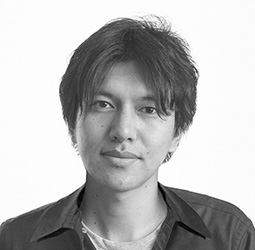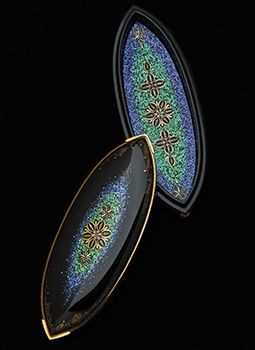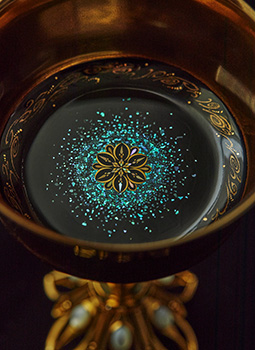May 2022
- English
- 日本語
The Pursuit of Radiance in Lacquer

Way of Light, a maki-e box with inlaid tortoiseshell and mother-of-pearl

Asai Yasuhiro 
Asai Yasuhiro’s Aogai natsume tea caddy (7 cm x 7 cm) 
Sea Route, a boat-shaped box with maki-e and mother-of-pearl inlay 
Pulse of Light, an ornamental maki-e box with inlaid tortoiseshell 
Earth, a takatsuki stemmed goblet with maki-e and mother-of-pearl inlay, viewed from above

A profile of lacquer artist Asai Yasuhiro

“It shines like a galaxy floating in space.” “It’s like being drawn into a mystery.” These are words of praise for Aogai natsume* (Blue shellfish tea caddy) by lacquer artist Asai Yasuhiro. The artwork, in which more than 10,000 extremely small shell fragments less than a millimeter across are pasted onto a lacquered wood surface, blends traditional lacquer work technique with a modern sensibility.
Lacquer crafts are made by applying multiple coats of the sap of the lacquer tree to kiji (a wooden base or unlacquered woodwork). Decorative techniques used include maki-e, in which pictures and patterns are drawn with lacquer and sprinkled with gold and silver powder before the lacquer hardens, and raden (mother-of-pearl inlay), in which fragments of shells with iridescent nacre such as abalone are applied to lacquer or inlaid into a carved lacquer surface.

The raden work Aogai natsume was born from Asai Yasuhiro’s desire to create a piece that maximizes the effect of the color differences inherent in shells. Asai made the piece by repeatedly lacquering a natsume tea caddy over a period of around six months and then spent another eight months pasting more than 10,000 tiny shell fragments onto the surface.
Asai says, “I started by selecting and pasting only the dark blue and dark green parts of the shell, but I could only get a small amount of these colored parts from each shell, so I sometimes wondered whether I should continue. To express subtle tones, I adjusted the spaces between the shell fragments while looking through a loupe or microscope, so I could only work on an area the size of the fingernail on my pinky each day, and I couldn’t really picture ever finishing the piece.”

Having overcome such difficulties, Asai’s finished artwork gives off a galaxy-like radiance that changes depending on the viewing angle and the light hitting it, and though small (7 cm x 7 cm), it is endlessly captivating. This is the charm of raden.
Asai first came across lacquer in an elective class in high school. Fascinated and enthused by lacquer’s beauty and the interesting way it is made, he continued to study the craft. After graduating, he became an apprentice to Murose Kazumi, a lacquer artist and living national treasure, and continued his training. In 2012, at the age of 29, he won the Newcomer Award at the Japanese Traditional Art Crafts Exhibition for Way of Light, a maki-e box with inlaid tortoiseshell and mother-of-pearl. In 2015, he received the Commissioner for Cultural Affairs Award at the Japanese Traditional Lacquer Art Exhibition for Pulse of Light, an ornamental maki-e box with inlaid tortoiseshell. He has created other important pieces such as the stemmed goblet with maki-e and inlaid mother-of-pearl, Earth, and the boat-shaped incense box with maki-e and inlaid mother-of-pearl, Sea Route, and he continues to work with lacquer in various ways.

In 2004, Asai started planting lacquer trees in his hometown of Tottori with his family. Since then, more than 200 lacquer trees have grown, and all his works use homemade domestic lacquer.
Asai says, “I am constantly aware that lacquer and lacquer crafts will outlive me. My techniques and methods are not mine alone, but something to pass on to the next generation. I want to introduce the beauty of lacquer art and maki-e not only to Japan but also to the world, and to leave works behind.”

With such sensibility and determination, Asai devotes his life to lacquer art.
* “Aogai natsume” means “blue shell tea caddy.” A natsume is a palm-sized container for matcha tea used in the tea ceremony. “Blue” is a traditional color in Japan that broadly refers to a range of colors from blue to green, also including indigo.

